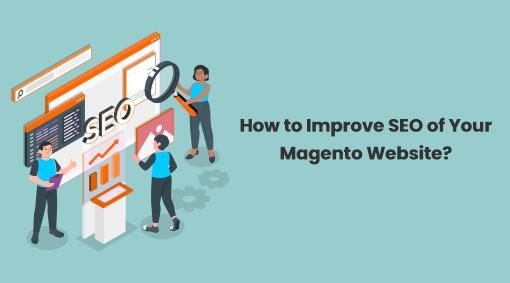When it comes to digital marketing, there are a lot of different ways to achieve success. One of the most effective methods is search engine optimization (SEO). SEO is the process of optimizing your website so that it appears higher in web search engine results pages (SERPs).
Ideally,
you want your website to appear first or near the top of an online search. This
will encourage visitors to click on your links and visit your site.
Everyone
from small business owners to big giant stores is trying to figure out how to
get more traffic and make their ecommerce sites more successful. What's the
best way to do that?
There
are a lot of different strategies you can use to achieve better ecommerce SEO.
The following tips provide some of the best practices that have been proven
time and time again to work. So if you're looking for ways to increase traffic
to your Magento ecommerce site, keep these strategies in mind
Checklist To Improve Your Magento 2 SEO:
Since
ecommerce stores are designed to sell products to customers, good SEO is
essential for successful marketing. In this article, we will discuss some of
the best practices that you can use to improve your site visibility and
rankings.
In
order to achieve optimal results from your SEO efforts, it is important to have
a sound plan in place. Also, you can take help from Magento 2 development
company that can help you boost traffic and
ranking dramatically.
There
are so many ways to get listed higher on Google and other search engines, and
for online businesses, effective ecommerce SEO is key. Let’ see how to improve
SEO in Magento 2?
1. Architecture your site appropriately
Your
website’s design and layout should be optimized for accessibility and usability
by both humans and search engines. Try to structure your pages logically, with
headings and subheadings that are easy to find. Be sure to create a site map or
sitemap if you have a lot of pages.
2. Optimize images
Images
play an important role in influencing search engine rankings, so make sure your
images are high quality and relevant to your content. Use alt text and name in
your image file names and upload them at the correct sizes (width × height) for
best results. Avoid using excessive image compression, which can decrease image
quality and impair viewer identification.
3. Content optimization
Optimize
content for load times, mobile devices, and desktop browsers, making sure all
of your content is easily accessible from any device or computer. Use titles,
metatags (tags used by robots crawling the internet), alt attributes (alternate
text associated with images), and other elements that help crawlers to index
and navigate your pages more easily. In addition, use 90% markup so that search
engines can better understand what’s on your page. What’s more? Make sure your
content is relevant for the users. Target the right keywords and insert them in
the content. Make sure your URL is keyword rich, SEO friendly and short.
4. Keyword Research
Find
the right keywords that are relevant to your industry and product. When it
comes to SEO, one of the most important aspects is keyword research. You need
to find the right keywords that will help you rank higher in search engines.
But how do you go about doing this?
There
are a few methods that you can use when researching keywords. The first is to
use keyword research tools such as keyword planner, ahref, semrush. These tools will show you which keywords are
being used more frequently and where they are being seen on the web. After you
have identified your target keywords, you need to decide which ones to choose
for your website.
Choosing
the wrong keywords can harm your website's rankings and potential traffic. Make
sure that you select the right ones for your site, and then do some research on
what those keywords might mean for your niche.
5. Meta Title & Meta Descriptions
Test
different titles and descriptions to see which ones are clicked more often.
Meta
titles and meta descriptions are incredibly important in SEO. They play an
essential role in helping your website show up in search engine results pages
(SERPs). By tweaking these properties, you can increase the visibility of your
site, drive more traffic and boost your conversion rates.
Here
are some tips for creating effective meta titles and descriptions:
●
Choose a catchy headline that captures
people's interest.
●
Be informative but concise – don't
overcomplicate things.
●
Use keyword phrases to target specific
segments of the population.
● Keep your tone light and entertaining so
that readers will stick around longer.
●
Use good grammar, punctuation, and
spelling - mistakes can damage your ranking status.
6. Mobile responsiveness and mobile friendliness
If your website is not mobile responsive, users will not be able
to comfortably view it on their phones. Mobile responsiveness includes
adjusting formatting, size, and position of elements based on the device being
used to view the site.
If you want your website to be successful in today's competitive
market, it needs to be mobile-responsive. Not only will this make your website
easier to use, but it will also allow you to attract more visitors who use
mobile devices as their primary mode of communication.
Make your website mobile-friendly and ensure that it looks
modern and professional no matter what device is being used to view it. You can
Google’s mobile friendly test.
7. Create an XML sitemap
Use
XML sitemap to make your website easier to crawl and index by Googlebot and
other search engines bots.
An
XML sitemap is an essential for optimizing your website's search engine
visibility. It tells search engines what pages on your website are relevant and
should be included in future search engine results pages (SERPs). Including
specific information in your XML sitemap will help Google better index your
site and improve your website's ranking. In addition, adding valuable metadata
to your sitemap will also help social media users find your website faster.
By
incorporating an XML sitemap, you can ensure that your website receives the
maximum exposure possible. And with timing being such an important factor when
it comes to ranking in Google and other major search engines, using an XML
sitemap is an invaluable investment for any ecommerce business.
8. Robots.txt
How do you make sure that your website isn't indexed by search
engines? If not, how do you make sure that people can't find it easily?
If you're unaware, robots.txt is a file used by search engines
to control what pages are indexed. By default, search engines are allowed to
index any page on your website, except for those with the Robots exclusion tag
in their HTTP headers. If you want certain pages excluded from being indexed,
you can include this tag in your web page's source code or on your server.
If you want to control which pages people can see when they use
a search engine to find information about your business or product, then including
this tag in your webpage's source code is vital. Not only will this stop people
from finding important pages on your website through search engine results
pages (SERPs), but it will also hide any errors or malfunctions that may exist
on that specific page. Furthermore, adding this tag to all the pages of your
website will prevent people from easily building links to those unwanted pages
without ever knowing it!
9. Loading speed
Website
loading speed is one of the most important aspects of a successful ecommerce
website. Visitors will abandon your site if it takes too long to load.
Unfortunately, many website owners don't understand how loading speed affects
their business. You can use Google page speed insight
tool for that. There are a number of factors that can affect the loading speed
of a website, including the following:
●
The design and layout of the site
●
HTML coding
●
The size and type of files used
●
The number and size of images used
By
following some simple SEO tips, you can help improve your website's loading
time. Here are a few suggestions:
●
Use compressed files whenever possible: By
using compression techniques, you can reduce the size of your files. This will
not only reduce the amount of bandwidth needed to load your site, but it will
also save you time by reducing the number of downloads required.
●
Minimize the use of images: Unless you
have a specific requirement for an image, avoid using them. Images that are not
essential to your text or viewing experience can be reduced in size by using
content delivery networks (CDNs). This will help to improve loading times.
●
Optimize page weight: Many modern browsers
support "pagination" – meaning that they can load multiple pages at
once, rather than waiting for each page to load separately. To ensure optimum
pagination support, make sure all your content is well organized into small
files that can be loaded quickly by the browser.
10. Fix Broken links
Check
for broken links and fix them before they become a problem for potential buyers
or visitors.
Follow the Best SEO Practices for Magento 2 Site
eCommerce
is a fantastic way to connect with customers and increase sales. However, it
can be difficult to get the most out of your website or store. To make sure
that your business succeeds online, follow these Magento SEO tips.










.jpg)


0 Comments